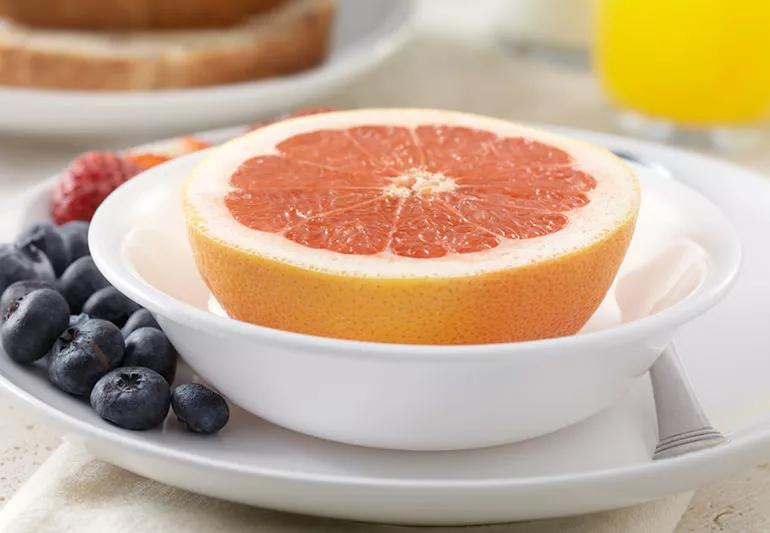Examining the eating plan’s fat-burning claims

One thing is undisputed about the grapefruit diet: It certainly has staying power.
Advertisement
Cleveland Clinic is a non-profit academic medical center. Advertising on our site helps support our mission. We do not endorse non-Cleveland Clinic products or services. Policy
The fad diet debuted in the 1930s amidst claims that its namesake fruit contains fat-burning enzymes that melt off pounds. Nearly a century later, it continues to draw attention and followers.
The eating plan (surprise, surprise) puts a big emphasis on a certain softball-sized citrus fruit. Grapefruit lands a high-profile role in every meal – breakfast, lunch and dinner.
The short-term diet’s main selling point is that it can help you lose 10 pounds during a 10- to 12-day detox. So is there any juice to that claim? Let’s squeeze out some information with dietitian Lauren Sullivan, RD.
For starters, you’ll chow on grapefruit – and lots of it.
Most versions of the diet include half a grapefruit with each meal of the day. The plans often allow you to sub in grapefruit juice if you’re feeling adventurous or don’t want to deal with a saw-toothed spoon.
After that, the primary focus of the diet is cutting waaaaay back on calories. Some plans suggest limiting yourself to as little as 800 calories in a day. That’s less than half of what is recommended for a healthy diet.
“Calories are energy for your body,” explains Sullivan. “Think of it like gasoline in your car. If you’re not fueling up properly, your engine is going to sputter.”
Advertisement
Other hallmarks of the classic grapefruit diet include eating foods rich in protein and high in fat and cholesterol. (Think eggs and red meat). The diet also tends to frown upon sugars and carbohydrates.
A sample meal on the grapefruit diet might include:
There is no one grapefruit diet, though, so guidelines tend to change plan to plan. The eating plan also carries several aliases, including the Hollywood diet.
Grapefruit offers many wonderful qualities, but being a miracle fat burner isn’t one of them. “It’s a healthy food,” says Sullivan. “It’s not magic, though.”
The fruit, however, does deserve consideration for your weight loss toolbox. A 2006 study showed that it “would appear reasonable” to include grapefruit in a diet designed to shed pounds. A 2011 study came to much the same conclusion.
Here’s why: Grapefruit is roughly 88% water, so eating it with meals tends to make you feel full faster. That, in turn, makes you eat less. (The nutrition pros call that concept “preloading.”)
As for the grapefruit diet’s quick weight loss claims, that’s more a byproduct of severely slashing calories. “You lose weight on the plan because you’re not eating as much,” says Sullivan. “It’s that simple.”
A word of caution for anyone considering the grapefruit diet: It’s definitely not a good idea if you’re on certain medications, including statins that help regulate your cholesterol.
Grapefruit contains a chemical compound that interferes with your body’s ability to process some medications. That affects the way the medicines work, leading to some serious health concerns.
The U.S. Food and Drug Administration requires warnings on some medications related to their use with grapefruit or grapefruit juice. If you’re on a medication, ask your healthcare provider if grapefruit is OK to include in your diet.
Don’t let the dubious claims about the grapefruit diet shape your opinion on the tropical fruit, says Sullivan. Overall, grapefruit offers an impressive nutritional resume. Highlights include:
Advertisement
On top of that, grapefruit packs a lot of taste without a lot of calories.
“Grapefruit is worth having in your diet,” says Sullivan, “but don’t base your whole diet plan around it.”
Advertisement
Learn more about our editorial process.
Advertisement

Choose foods that are low in fiber and easy to chew and swallow

The flexible eating plan aims to boost your brain health by focusing on plant-based foods and limiting saturated fat

Designed to lower your blood pressure, this eating plan focuses on heart-healthy foods like whole grains, fruits and vegetables

Pescatarians don’t eat poultry, game or red meat, but they do eat fish and seafood, dairy and eggs

This eating style has many health benefits, including weight loss, an improved microbiome, and increased nutrient and mineral consumption

Research shows promising results from options like the DASH diet and Mediterranean diet

Studies show intermittent fasting may help you lose weight, improve blood pressure and more

Some people can safely lose weight on just 1,200 calories — but it’s not right for everyone

Start having sex about 72 hours before ovulation, then at least every other day during your fertile window

Attachment theory suggests that your earliest relationships shape connections throughout your life

It isn’t a recognized mental health disorder, but research shows that problematic social media use can negatively affect your mental health, self-esteem and sleep